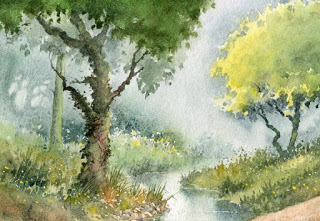One event in the year that I especially look forward to is the Patchings Art Festival, and I shall be demonstrating there once more on the fabulous Saunders Waterford and Bockingford papers, in the St Cuthberts Mill marquee on the mornings of 13th, 14th and 15th July. If you’ve never been, do treat yourself this year as it is a terrific show in lovely surroundings, and overflowing with artists demonstrating their various styles. There’s no place quite like it for being supercharged with artistic inspiration!
This is just part of a small watercolour as I want to highlight more of the detail, and some of the techniques used I will be showing at Patchings. The moody background was created with the wet-into-wet method, with the whole of the background carried out with just burnt umber. Whilst the wash was still wet I suggested the trees with a rigger, the larger ones with a number 4 brush, and with hardly any water on the brush – almost pure paint so that it did not run. Naturally I test it on the side first to check if the timing is right.
On this side of the bridge I introduced other colours: yellow ochre, cadmium red and French ultramarine. My aim was to keep the colours in harmony, all in the brown-ochre segment of the colour wheel. The ultramarine, of course is not in that category, but I’ve mixed it in such a way that it is simply darkening the effect with burnt umber, and not displaying any sign of its blueness. Adopting this approach will give your work a great feeling of unity.
I hope to see you at Patchings in July and for further information on the Patchings festival check out these links:
- To book tickets https://patchingsarts.tygit.com/shop/groups/pk/dc4104183eabdf2c336eaec6dae4fba8
- Patchings page https://www.patchingsartcentre.co.uk/patchings-festival/
- Patchings Instagram https://www.instagram.com/patchings_art/
- St Cuthberts Mill webpage: www.stcuthbertsmill.com
- St Cuthberts Mill Instagram: https://www.instagram.com/st_cuthberts_mill/







